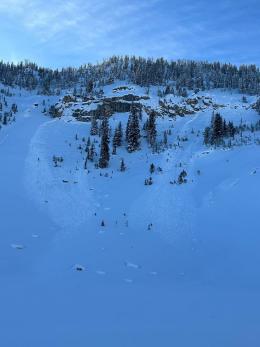Good morning. This is Ian Hoyer with the Gallatin National Forest Avalanche Forecast on Friday, December 15th at 7:00 a.m. This information is sponsored by Spark R&D, and Klim. This forecast does not apply to operating ski areas.
As of today, Bridger Bowl is open and closed to all uphill traffic for the duration of its operating season.
There is no new snow. Mountain temperatures are in the teens F to 20s F this morning with an inversion keeping valley temps a bit lower in the south. Winds are 10-20 mph out of the west to northwest. High temperatures today will be in the 20s and 30s F under blue skies with light westerly winds.
All Regions
Triggering large, dangerous avalanches is a very worrisome possibility today. It’s been around four days since the last snowfall and a week since the last more substantial storm. This has brought the likelihood of triggering a slide down a little bit, but we are still a long way from trusting the snowpack. Weak snow near the ground is widespread and people continue to get large collapses and whumpfing across the advisory area (see the wx and avalanche log). On the other hand, it has been three days since our last report of a human triggered avalanche (Mt. Blackmore video), which reflects that lowering likelihood. However, recent avalanches indicate that any slide that you do trigger is likely going to break near the ground and with thin coverage will probably drag you over rocks (increasing trauma risks) before potentially burying you (Big Sky slide, Tepee Basin slides, Mt. Elephant avalanche).
As the probability of triggering a slide decreases, decision making becomes more difficult. You might be able to get away with riding a steep slope today. But you might not. Assessing the probability that any particular slope will avalanche will be difficult and has a large uncertainty. Entering avalanche terrain today is not a decision to make lightly. Choosing to continue to avoid slopes steeper than 30 degrees is a very reasonable option.
Be very cautious if you do decide to ride steep slopes. Do your homework by reading recent observations and weather data. Dig a snowpit. Be ready and alert for signs that you should back off (e.g. cracking, collapsing, recent avalanches, or poor stability test scores). Assess the terrain and think about the consequences of triggering a slide. Have an escape and rescue plan in place.
Human triggered avalanches are possible and the avalanche danger is rated MODERATE.
If you get out, please submit an observation. It does not need to be technical. Did you see any avalanches? How much snow is on the ground? Was the wind moving snow? Simple observations are incredibly valuable. You can also contact us via email (mtavalanche@gmail.com), phone (406-587-6984), or Instagram (#gnfacobs).
Upcoming Avalanche Education and Events
Our education calendar is full of awareness lectures and field courses. Check it out: Events and Education Calendar.
We offer Avalanche Fundamentals with Field Session courses targeted towards non-motorized users in December and January and one geared towards motorized users in January. Sign up early before they fill up.
Loss in the Outdoors is a support group for those affected by loss and grief related to outdoor pursuits. Check out the link for more information.
Listen to GNFAC Forecaster Dave Zinn on the Hoary Marmot Podcast for some extracurricular avalanche talk (link to episode).


